Samsung NX 50-200mm f/4.0-5.6 ED OIS II iFunction Lens Review
Samsung NX 50-200mm f/4.0-5.6 ED OIS II Performance
At 50mm and maximum aperture sharpness approaches very good levels across the frame. Stopping down improves performance and peak quality is achieved at f/8, where sharpness is outstanding in the centre, and excellent towards the edges of the frame.At 100mm sharpness in the centre of the frame dips just below good levels and to fairly good levels towards the edges of the frame. Peak quality is again achieved at f/8 where sharpness in the centre is excellent, with very good sharpness towards the edges of the frame.
Finally, at 200mm, overall sharpness levels drop off slightly, but remains good in the centre, but drops to fair levels towards the edges. Peak quality is achieved between f/8 and f/11 where centre resolution is very good, with fairly good clarity towards the edges of the frame.
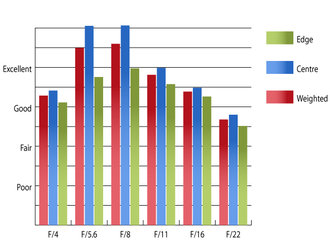 Resolution @ 50mm | 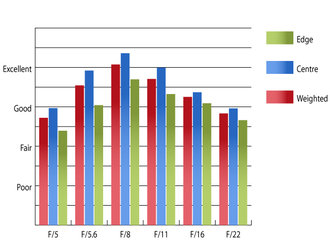 Resolution @ 100mm | |
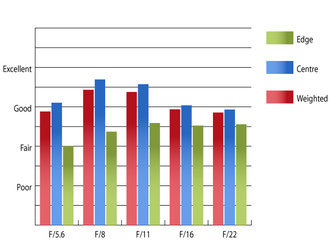 Resolution @ 200mm | How to read our chartsThe blue column represents readings from the centre of the picture frame at the various apertures and the green is from the edges. Averaging them out gives the red weighted column.The scale on the left side is an indication of actual image resolution. The taller the column, the better the lens performance. Simple. For this review, the lens was tested on a Samsung NX20 using Imatest. |
Chromatic aberrations are kept under reasonable control, reaching a level of just over a pixel width in the centre of the frame at 100mm. This level may pose some issues in large prints with high contrast edges.
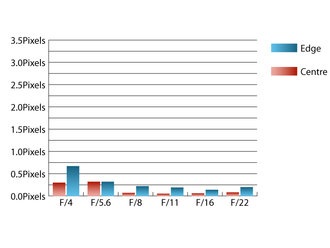 Chromatic aberration @ 50mm | 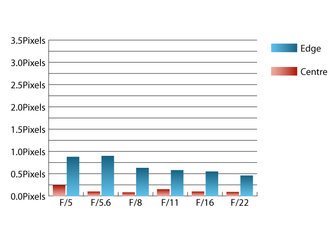 Chromatic aberration @ 100mm | |
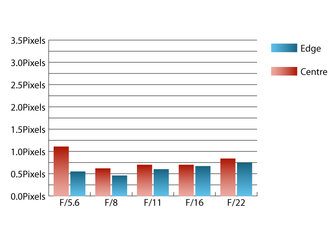 Chromatic aberration @ 200mm | How to read our chartsChromatic aberration is the lens' inability to focus on the sensor or film all colours of visible light at the same point. Severe chromatic aberration gives a noticeable fringing or a halo effect around sharp edges within the picture. It can be cured in software.Apochromatic lenses have special lens elements (aspheric, extra-low dispersion etc) to minimize the problem, hence they usually cost more. For this review, the lens was tested on a Samsung NX20 using Imatest. |
Falloff of illumination towards the corners is very well controlled throughout the zoom range, with corners being 0.388 stops darker than the image centre at maximum aperture at 50mm and 0.5 stops darker at 200mm. Stopping down by one stop from maximum aperture results in visually uniform illumination.
Distortion is very well controlled, with a virtually negligible amount of pincushion distortion detected by Imatest at 50mm, and only 0.344% pincushion at 200mm. These low levels of distortion should barely be visible and should very rarely need correcting.
Add your message
Login required
Please login here or if you've not registered, you can register here. Registering is safe, quick and free.
Please login here or if you've not registered, you can register here. Registering is safe, quick and free.
photodo Stats
1102 lenses
428 MTF tests
74 in-depth photodo reviews
100+ users join each day
Help the lens community by reviewing or rating a lens today via our lens search
428 MTF tests
74 in-depth photodo reviews
100+ users join each day
Help the lens community by reviewing or rating a lens today via our lens search
Latest Lens Reviews
- Chinon 28mm f/2.8 Vintage Lens Review
- Canon EF 70-200mm f/4L IS II USM Lens Review
- Samyang AF 85mm f/1.4 EF Review
- Sigma 70mm f/2.8 DG Macro Art Review
- Samyang AF 24mm f/2.8 FE Review
- Meike 50mm f/1.7 Review
- Tamron 70-210mm f/4 Di VC USD Review
- Lensbaby Burnside 35mm f/2.8 Review
- Asahi Super Takumar 50mm f/1.4 Review
- Asahi Super-Multi-Coated Takumar 135mm f/3.5 Review
